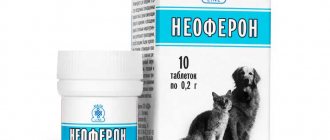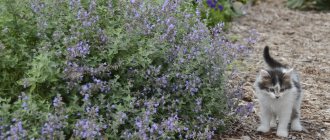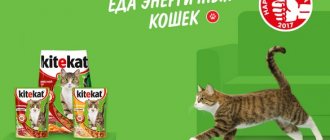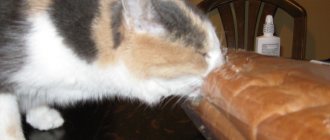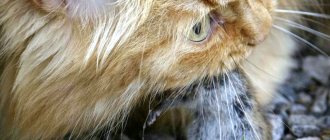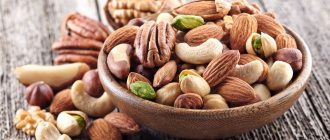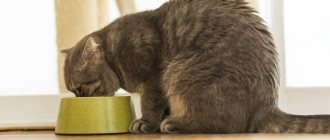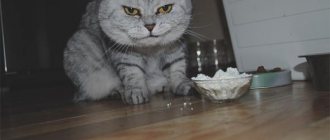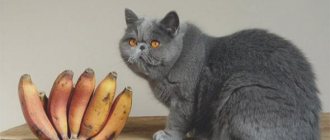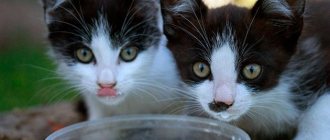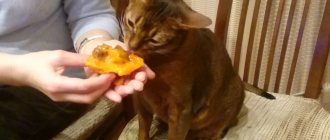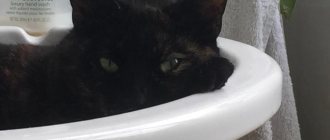What is taurine and why does a cat need it?
Taurine is an organic compound that in mammals is produced in the liver and accumulates in muscle tissue, the retina, and the central nervous system. However, in cats, the process of taurine formation is very poorly developed, so they can only obtain this substance from food.
What are the benefits of taurine?
Taurine has the following beneficial properties for the cat's body:
- prevents the development of eye diseases;
Taurine supports cat eye health
- has a positive effect on the functioning of the cardiovascular system - taurine is often prescribed to cats not only for prevention, but also for the treatment of heart failure and arterial hypertension;
- improves the functioning of the gastrointestinal tract: forms healthy intestinal microflora, prevents diarrhea and constipation;
- normalizes metabolism;
- strengthens teeth and musculoskeletal system;
- increases muscle tone;
- activates the body's defenses;
- protects the cat’s body from free radicals - molecules that change the normal structure of proteins and provoke the development of cancer;
- improves brain function;
- regulates hormonal levels.
The daily dose of taurine for a cat is 450–500 mg per 1 kg of weight.
Taurine deficiency in cats: symptoms and consequences
The lack of this useful substance is very dangerous and can lead to sad complications. The most common consequence of taurine deficiency in cats is degeneration of the central retina. The pathology often ends in deterioration or complete loss of vision. The disease does not cause pain, so the cat behaves calmly and the owners may not immediately notice that their pet is unwell. The first symptom of degeneration of the central retina is night blindness: cats have poor orientation in dark rooms and can bump into objects when moving. An additional sign of the disease is the dilation of the cat’s pupils.
Taurine deficiency can lead to other consequences:
- disruption of the activity of the myocardium - the main muscular layer of the heart, the disease can be accompanied by the following symptoms: difficulty breathing;
- lack of appetite;
If a cat refuses a favorite treat, this may indicate the development of taurine deficiency.
- deterioration of coat condition;
- bleeding gums;
In kittens, taurine deficiency can cause the following health problems:
- growth slowdown;
- curvature of the spine and limbs;
- impaired coordination of movements;
- frequent respiratory diseases, which are usually accompanied by lacrimation, coughing, sneezing, and high fever;
Kittens with taurine deficiency are susceptible to frequent colds
- slow teething.
Spices and seasonings: why do cats need salt and seasonings?
Many feeds contain spicy and aromatic additives; they were identified during histological analysis of wet feeds. Note that no research has been carried out on this indicator in dry food, since dry food is finely ground and compressed. Therefore, there are no histological methods for such a research object. But wet food provides the opportunity to conduct a histological examination.
Only Friskies, Brit, Gourmet and Schesir did not contain additives. Such additives are used to make the animal's food more attractive. However, these are not flavor enhancers, but ordinary spices such as dill or pepper. Why are they added, says Sergei Kolomiets
:
– Cats have a very developed sensitivity to aromatic oils. Therefore, spices have a significant impact on the attractiveness of food. In addition, spices are phytobiotics that prevent diseases of the intestinal tract.
In addition to spices, spices - salt - are added to the food. If the food is too salty, then it is better not to give it to the animals.
According to GOST, sodium in food for adult animals (not kittens or pregnant cats) must be at least 0.2%. However, there is no upper limit. The food can be as salty as you like. And this can lead to problems. Cats with kidney problems, or animals of specific breeds, or neuters should not eat food containing excess sodium.
From the reference book “Feeding Dogs and Cats”:
Table salt contains sodium, and cats are very sensitive to NaCl (salt), which contains about 0.3 g of sodium per gram. A dose of 3.5–4 g of salt per kilogram of live body weight is lethal (Khokhrin S.N. Feeding dogs and cats. Handbook. - M.: KolosS, 2006, p. 47).
STO Roskachestvo limits the upper limit. Sodium in the feed should be 1–15 g/kg (or 1000–15000 mg/kg dry matter). Found in the studied feeds from 6000 to 13070 mg/kg, which is within the recommended range.
No sodium was detected in the feeds of the three HMs (below the detection limit, less than 1000 mg/kg).
Sergei Kolomiets
explains why sodium-free food is bad.
– Sodium is necessary to maintain osmotic pressure and constant fluid volume in the body. Sodium takes part in the transport of amino acids, sugar and potassium into the cells of the body. When sodium is deficient, nutrient absorption is reduced and nutritional deficiencies may occur.
Features of digestion
The domestic cat very rarely gets its own food, and, nevertheless, by nature it remains a predator. This is evidenced not only by the habits of the hunter, but also by the structural features of the teeth, designed for capturing and tearing raw meat. Cats lack the molar chewing teeth that omnivores have.
Cats eat calmly and measuredly, carefully sorting and chewing their food. Even in almost homogeneous food, they will definitely find something they don’t like. These features have given the animals a reputation as capricious and picky eaters. Therefore, cat food, both at home and in industry, is made from higher quality ingredients than, say, for dogs. In addition, cats prefer warm food. This is due to their carnivorous nature. In nature, these predators eat only fresh meat. Smell and taste are of great importance to cats.
Conservative in food and habits, they are reluctant to try new foods
And to attract the attention of gourmets, the industry adds special flavoring components. Cats are indifferent to sweets because they simply cannot distinguish the taste
A very important point in the attractiveness of cat food is its moisture content, consistency, hardness and size of the ingredients.
There is starch, but no flour and soy
Another fear of animal owners is that wet food contains starch, soy, and thickeners. There is indeed starch in food, but not all (details in product cards). There is no starch in Purina, Royal Canin, Sheba, Nature's table, Brit and Schesir foods.
All feeds do not contain, judging by the examination data, the thickener carrageenan and guar and carob gum, peas, soy concentrate, textured soy protein product, fermented rice, flour, isolated soy protein.
Advantages
First, let's talk about the advantages of using dry pet food.
Owners of domestic cats note convenience as the first advantage. It is very easy to store food this way. You can use any convenient container for storage. You can also leave the product in its original packaging.
Plastic containers, which are found in every home, will work great. Separately, it is worth noting the long shelf life of the products and convenient use. To feed your furry pet, just open the package and pour the required amount of food into a bowl.
Manufacturers offering products of the highest quality produce food with a balanced composition. First of all, a premium product has this quality. Properly selected components and substances are necessary for the excellent health and well-being of your pet.
Without the use of ready-made food, cat owners have to create their own menu, taking into account the characteristics of a particular breed and the beneficial qualities of each individual product. Trading companies offer food for various age groups, taking into account the developmental characteristics of cats at each stage.
If you are the owner of a purebred cat, you will definitely be interested in breed-specific food. It is very difficult to independently select and calculate a menu for a specific type. Manufacturers have already done this for you and have taken into account the characteristics of each breed. When preparing food, the pet’s predisposition to disease, taste preferences, need for certain substances, and much more are taken into account.
It is especially worth noting medicinal food, which helps animals recover after surgery or illness. They contain special components aimed at improving the condition of the body. You will also find formulations for pregnant and lactating cats on sale.
The next advantage is the abrasive properties of solid food granules. This food helps cleanse teeth from plaque. However, even with regular use of dry food, it is necessary to brush your pet's teeth. Unfortunately, some owners neglect this responsibility.
The product contains taurine. This is a special component that is essential for the health of the animal. This element is required for:
- maintaining excellent vision of the animal;
- prevention of heart disease;
- participation in digestive processes (the substance helps digest and absorb fat in the small intestine);
- stabilization of the nervous system.
Taurine is found in fish, beef and seafood. If such food is rarely or completely absent from the cat’s diet, dry food will help cope with the problem of taurine deficiency. READ Antigadin for cats
About products
The rating of wet food for adult cats includes 20 TM products. These are economy and premium segment food produced in Russia (16 TM), Czech Republic (1 TM), France (2 TM) and Thailand (1 TM). The list included wet food in three formats: pate, pieces in jelly and pieces in sauce. The moisture content of these feeds varies from 76 to 85%. None of the goods are produced according to GOST. The goods are manufactured according to our own technical specifications (TS) or other regulatory documents. Feeds 15 TM are declared as complete rations, one is intended for an additional diet, on four feeds there is no message about completeness/non-completeness.
Of these foods, 19 are intended for healthy cats that do not have any pathologies, one is intended for dietary nutrition. This food was taken into the sample for the purpose of comparison; in the future, Roskachestvo will study other food in this category. An analysis of wet cat food showed that even the special purpose of the food does not guarantee the buyer the authenticity of the labeling. Details in product cards.
Package weight – from 85 to 415 g. Purchase cost – from 7 to 160 rubles per 100 g.
Previously, Roskachestvo examined dry cat food. Details HERE
.
The food tested was poultry flavored, namely chicken (2), as it is the most popular. This was confirmed by the results of a survey of visitors to our portals and social networks. Poultry food (chicken, turkey, etc.) is purchased by 71% of respondents. We thank everyone who takes part in Roskachestvo surveys!
Russian quality system standard
The standard of the Russian quality system for wet food (for cats), applying for the Russian Quality Mark, has established advanced requirements for the amount of dry matter, mass fraction of protein, moisture (at least 60%), raw ash, calcium, fiber and phosphorus, as well as acid and peroxide number of fat. The standard sets standards for the content of amino acids, vitamins and microelements. According to the standard, preservatives (sorbic and benzoic acids) and dyes are not allowed in cat food.
The testing program additionally included determination of the content of histamine, GMOs, antibiotics and pesticides in feed.
Products that comply with the standards specified in the STO have the right to apply for the Russian Quality Mark. The level of localization of production for the assignment of the Russian Quality Mark must be at least 70% of the cost of the product.
The requirements of the Roskachestvo standard are voluntary and are not mandatory for the manufacturer. If the product meets the advanced requirements of the Roskachestvo standard, the manufacturer receives the right to apply for product labeling with the Russian Quality Mark.
Treatment of taurine deficiency, prevention
Nutritional supplements have come to the rescue of worried cat owners. They have been proven to slow down/stop retinal atrophy, and also cope with dilated cardiomyopathy (especially at its onset), and generally improve the cat's well-being and appearance.
Taurine Supplements
They are safe and very rarely cause side effects, such as allergies or stomach upset. Excess taurine that the body does not absorb is removed from it in the urine. So, vitamins with taurine:
- Beaphar Kitty's Taurine + Biotin (cheese flavor). The package contains 180 vitamins, each of which, along with taurine, contains a set of essential microelements;
- Gimpet – recommended for cats of all breeds. The amino acid is also supplemented with a complex of daily microelements;
- Omega Neo - here taurine and other amino acids are isolated from squid liver. Daily dose – 3-6 tablets, taken year-round;
- Petvital Vitamin-Gel is a vitamin gel with taurine and other active ingredients that prevent stone deposition. The gel is also prescribed to neutralize the negative effects of low-quality industrial feed;
- Doctor ZOO for cats Biotin + Taurine – accelerates metabolism, maintaining the balance of taurine, biotin and trace elements.
Secrets of Taurine
Veterinarians at the University of California have experimentally determined which foods contain the most taurine (more on that later) and how to preserve it during cooking.
The researchers concluded that cooking errors directly affect the concentration of a sulfur-containing amino acid, which can quickly dissolve in water.
Some advice from American veterinarians:
- try not to freeze meat/fish, as the amino acid is easily washed out when defrosted;
- do not chop the pulp too finely and do not put pressure on it: this contributes to the destruction of taurine and other useful elements;
- the most noticeable loss of taurine occurs during cooking in water, where it is simply washed out;
- if you boiled meat, use broth so that the animal receives the amino acid that migrated there.
Important! Most taurine is found in raw foods, slightly less in fried foods, and very little in those that have been boiled.
Symptoms of food allergy in kittens and adult cats
Food allergies in cats have varying severity, directly correlated with age, physiological characteristics, frequency of exposure to allergens and body resistance. A food allergy in cats is manifested by the following characteristic signs:
- the appearance of severe itching on the skin;
- the appearance of areas of alopecia (especially in the area of the muzzle, ears and chest);
- seborrhea;
- copious clear discharge from the eye area and nasal passages;
- swelling in the eyelid area;
- violation of the condition of the coat (it becomes dull, hard and unkempt in appearance).
In advanced cases of food allergy, the animal begins to suffer greatly, and changes in the body against the background of a specific reaction can lead to serious complications. Symptoms of untreated food allergies are characterized by the following manifestations:
- pallor of visible mucous membranes;
- bloating and increased gas formation;
- violation of skin pigmentation;
- the appearance of an unpleasant, repulsive odor from the pet’s mouth;
- violation of the act of urination;
- coating on the tongue is white or gray;
- swelling on the body and inflammatory manifestations on the ears.
The danger of food allergy lies in its sluggish, almost asymptomatic course in the first stages. As a rule, the owner of the animal does not attach importance to the pet’s lethargy, refusal of treats and apathy, citing the pet’s lack of mood. But all this can be signs of a food allergy, so if the animal shows any signs of ill health, it is recommended to consult a veterinarian.
In addition, any allergy that manifests itself as itching on the skin causes the pet to itch, which in turn leads to injury to the skin and the introduction of pathogenic bacterial microflora there.
As a result, everything can turn into serious treatment with the use of broad-spectrum antibiotics.
Symptoms of Taurine Deficiency
There are no direct symptoms of taurine deficiency. All signs are associated with developing diseases, primarily dilated cardiomyopathy and retinal degeneration. Therefore, differential diagnosis with these diseases is carried out.
If a plasma analysis shows a taurine content of less than 25 nmol/ml, then they speak of taurine deficiency. In healthy cats, this figure is 50 nmol/ml or higher. However, the result is influenced by how much amino acid was supplied with food before the study or by prolonged fasting. Therefore, it is difficult to judge from the result how much substance the animal lacks. More accurate data is shown by whole blood analysis. A cat is healthy if the taurine level in whole blood is 250 nmol/ml or higher. If it is lower, a deficiency is diagnosed.
What does an overdose lead to?
An excess of taurine in cats is rare. More often in kittens. Leads to muscle weakness and the development of chest pathology - funnel chest.
Side effects of taurine
Taurine can reduce the number of diseases affecting blood vessels and the heart.
This is due to the fact that the substance lowers blood pressure and also alleviates inflammation. Thanks to relevant research, it was possible to find out that the introduction of taurine into a regular diet, even if only for a short time, can provide an increase in the physical performance of the body.
Reduce the risk of heart and vascular diseases that can occur as a result of excessive physical activity. In addition, it improves the general condition of patients who are concerned about heart failure. Taurine has also been shown to help people with congestive heart failure by increasing the strength and efficiency of heart muscle contractions.
Reduces side effects of Parkinson's disease
The results of medical experiments indicate that this acid can provide all possible assistance in the restoration of brain cells. Tests have shown that taurine accelerates the growth of brain cells. This happens due to the activation of stem cells and an increase in the overall lifespan of neurons.
Helps restore the body after metabolic disorders
Scientific research conducted with the participation of not only animals, but also people, helped to reveal another interesting fact. Taurine is able to provide all possible assistance to people suffering from obesity and metabolic disorders in the body. Improvement in the condition occurs due to lower blood cholesterol levels and stabilization of blood pressure. Dietary taurine has a positive effect on blood cholesterol levels in overweight young people.
Can speed up the treatment of periodontitis
As a medical experiment, people suffering from periodontitis were observed by experienced dentists for some time. The purpose of the observations was to find out whether taurine helps the process of tissue repair. According to the data obtained, the acid was able to significantly increase the concentration of antioxidants in all patients. Mainly due to an increase in the level of lipid oxidation and corresponding enzymes. Which accelerated the progress of periodontitis treatment.
Helps stimulate athletic performance
Taurine may increase physical activity and, with it, athletic performance. A group of scientific researchers from one of the Scottish universities conducted a special study of the success of runners. The subjects ran an average distance, and the scientists carefully recorded the indicators before and after using acid as a dietary supplement.
The research result exceeded all expectations. Nine out of ten subjects showed significant improvement in athletic performance. Yes, just for a few seconds. But it’s no secret that in such competitions a few seconds can decide the outcome of the entire competition.
Helps regulate physiological functions
In cells, taurine retains potassium and magnesium, while preventing excess sodium. In this sense, it works as a diuretic. Because it helps move potassium, sodium, and calcium in and out of cells, taurine is used as a dietary supplement for epileptics and for people with uncontrollable facial twitching.
Taurine against atherosclerosis and coronary heart disease
Taurine has been shown to reduce apolipoprotein B100 and lipid secretion in hepatitis G2 cells. High concentrations of serum lipids and apolipoprotein B100 (the most important structural component of very low-density lipoprotein and low-density lipoprotein) are the main risk factors for the development of atherosclerosis and coronary heart disease. Therefore, taurine supplementation may be beneficial for the prevention of these diseases.
Many people know what taurine is and what benefits and harms this acid has for the human body. Taurine is very important for women and men of different ages. Among the significant advantages of the substance:
- the ability to control weight and stabilize metabolism;
- prevention of eye diseases, diabetes, heart failure;
- prevention of cancer;
- beneficial effect on the entire body.
Among the owls of this component:
- may cause overload of the heart muscle;
- helps reduce blood pressure;
- causes excessive bile production.
You can hear a lot about this acid, both positive and negative. However, there are still more positive reviews from all those who once used a biologically active substance in their diet, although not everyone knows what taurine is needed for. The benefits of this biologically active substance are undeniable:
- It is an excellent antioxidant that can prevent the occurrence of cancer.
- Reduces glucose levels, which is important for people suffering from diabetes.
- Participates in the formation of the retina and promotes its recovery after injury.
- It can lower blood pressure, which means that the risk of developing atherosclerosis is low.
- Has a beneficial effect on the functioning of the heart.
- Helps the body release additional energy in stressful and extreme situations.
Taurine is harmful
Popular among athletes and those losing weight, the biologically active substance has a number of beneficial properties for the average person. However, this acid is not useful for everyone. Often before consuming it, people ask why taurine is harmful. Such concerns are not unfounded, since due to the excessive activity of the substance there are risks of cardiac overload, decreased blood pressure and excessive bile production. This component is not recommended for use if you have:
- liver diseases;
- cholelithiasis;
- ulcers of the stomach and duodenum;
- hypotension;
- heart failure;
- pregnancy
This biological component should not be abused. Otherwise, the body will work for wear, the acid will not be able to have a beneficial effect on the body, but will only harm it. Taurine can become dangerous for the heart and brain, resulting in reduced attention, stress resistance and performance. Doctors do not recommend combining the active substance with alcohol and coffee. Such combinations may have a negative effect on the circulatory system.
What foods contain taurine?
Taurine was originally discovered in bovine meat, as its name indicates. However, not every owner has the opportunity to constantly prepare treats containing taurine for their pets.
In this case, industrial types of feed with taurine are ideal. In addition, special fortified supplements are available for sale, which can be included in the animal’s diet along with its usual food.
Before choosing vitamins for cats, you should consult a veterinarian, as some animals may be allergic to some components of a particular product. Even if the instructions indicate that this drug is completely safe, you should carefully study its composition.
Next, you should pay attention to the price-quality ratio. You shouldn't skimp on your pet's health
Cheap vitamins can harm your cat's health. However, if there is no opportunity to purchase expensive foreign vitamins, then you should take a closer look at domestically produced goods.
- Beaphar Kitty's Taurine + Biotin are heart-shaped vitamin treats that taste like cheese. Available in packs of 180 pieces. The weight of one package is 151 grams. In addition to taurine, these vitamins contain a complete daily set of microelements.
- Omega Neo is also a fortified treat. Each tablet contains squid liver, which provides the animal’s body with essential amino acids, in particular taurine. The daily dose is three to six tablets. Can be taken throughout the year. No contraindications have been identified.
- Gimpet are delicious vitamins shaped like mice or hearts. Taurine is present in the composition along with trace elements. Available in different packages. Kittens can be given 3-4 tablets per day, and adult animals - up to six. Suitable for cats of all breeds.
- Doctor ZOO for cats Biotin + Taurine is a useful addition to your pet’s daily diet. Improves the metabolic process. Maintains the body's natural balance of biotin, taurine and trace elements. Produced in packs of 90 tablets.
- Petvital Vitamin-Gel is a vitamin gel that contains taurine, as well as other substances necessary to maintain the normal functioning of your pet. It contains a number of active substances that prevent the development of urolithiasis, which in turn significantly increases the life expectancy of the animal and reduces the possible negative effects of some dry foods.
Thus, vitamins with taurine will not only normalize the content of this substance in the animal’s body, but will also take care of stabilizing the metabolic process, increase the amount of microelements necessary for fiber and protect against serious diseases.
Taurine in cat food: harm or benefit
The benefits of taurine are mentioned above.
There have been proposals to use taurine in the diets of some breeds of dogs and humans, and positive results have been obtained. However, all substances heal in small quantities, but become toxic in large quantities. The body responds to a significant increase in the concentration of nutritional components by reducing food consumption. This is true for almost all substances except taurine. An attempt to establish the toxic dose of taurine failed. And no decrease in feed consumption was observed.
However, harm from an overdose of taurine still exists. Thus, the cost of a package of 60 tablets of the Sevavit feed additive is 600 rubles. A large cat requires 6 tablets per day, the period of use is unlimited. Therefore, the harm to the cat owner’s pocket is quite real.
How to fix the situation
Cats begin to replenish taurine by correcting their diet. The animal is switched to premium and super premium food, or meat and fish are introduced into the diet. The transition to a new type of food or a new brand of food is carried out gradually, over 2 weeks, to avoid stomach and intestinal upset.
But in addition to replenishing the diet with amino acids, tablets or powders are additionally prescribed. For example, Debikor. The dose for a cat is 250 mg twice a day. The course is at least 3 months. The “excess” substance, which is not absorbed by the body, is excreted in the urine without causing harm to health. The animal's condition returns to normal within 1-2 weeks.
In cats with heart failure caused by taurine deficiency, a special diet slows the progression of the disease and even cures it in some cases, while also minimizing medication use. Over time, a cat's heart regains its shape, size and all functions. In this case, it is necessary to introduce taurine supplements into the diet for several months.
Why do cats need taurine?
Taurine is an amino acid that helps cells produce proteins necessary for the proper functioning of the cat's body. Participates in the formation of bile to digest fats in the small intestine, reduce cholesterol and blood pressure. The benefit of the amino acid lies in its assistance in metabolic processes, storage and transportation of nutrients. The element is needed to control blood sugar levels, maintain the health of the urinary system, and visual organs.
Cats, unlike humans and dogs, do not produce taurine. The amino acid must be supplied to them with food.
In cats, the need for taurine is 400 mg per 1 kg of body weight.
If you do not receive enough of this acid, your health begins to deteriorate over time. Deficiency develops between 5 months and 2 years. The process is long and symptoms do not appear externally.
Taurine Supplements
Nutritional supplements with taurine are an effective means for the prevention and treatment of taurine deficiency. Preparations may include only taurine or contain other useful components.
Table: food supplements with taurine, their composition and release form
| Product name and manufacturer | Content of taurine and other useful substances in 1 kg of product | Release form |
| Top 10 (Beaphar BV, Netherlands) |
| Pills |
| Kittis (Beaphar BV, Netherlands) |
| Pills |
| Feed additive Taurin (Canina, Germany) | Taurine – 700 mg | Powder |
| Petvital Vitamin gel with taurine (Canina, Germany) |
| Gel |
Photo gallery: dietary supplements containing taurine
Reception scheme
Each dietary supplement must be accompanied by instructions containing information about the dosage regimen for the drug. However, you should consult your veterinarian before using any drug.
How to use dietary supplement Top 10
The nutritional supplement is recommended for cats over two months of age. The drug is used daily, once a day. Other reception features:
- a single dosage for kittens aged 2 months to 1 year is calculated according to the following scheme: 1 tablet per 1 kg of body weight, duration of use - 4-5 weeks;
- For adult cats, the drug is prescribed in a dose of 3–6 tablets per 5 kg of weight, the course of use is 2–4 weeks;
- single dosage for pregnant and lactating cats - 1 tablet per 5 kg of weight, duration of treatment - 8-9 weeks.
The manufacturer recommends using the dietary supplement for adult cats as a preventive measure for taurine deficiency annually in spring and fall.
To help your cat swallow tablets containing taurine, you can use the following methods:
- crush the tablets and mix with wet food, and if you feed your cat natural food, then the medicine can be added to porridge or cottage cheese;
- forcefully place the tablet on the root of the cat's tongue.
Rules for using the Kittys product
Kittis is prescribed to cats over six months of age. The medicine can be given to pets daily and year-round. Recommended daily doses:
- kittens aged 6-12 months - 2-5 tablets;
- cats older than one year - 3-6 tablets.
The instructions for the drug indicate that the Kittis product is not contraindicated for cats during pregnancy and lactation, but the dosage is not specified.
Algorithm for receiving products from the manufacturer Canina
The nutritional supplement in powder form can be mixed with wet or dry food. In this case, dry food should be pre-soaked with water. The drug is given once a day. Daily dosages:
- cats over 1 year old weighing up to 6 kg - 1/2 teaspoon;
- cats over 1 year old weighing more than 6 kg - 1 teaspoon;
- cats under one year of age, as well as during pregnancy and lactation - 1 teaspoon.
Petvital Vitamin gel with taurine is given to kittens and young cats daily, 0.5 teaspoon. The daily dose for adult animals is 1 teaspoon.
Canina products can be used all year round.
Contraindications and side effects
There are no contraindications for taking taurine supplements. As a rule, no side effects are observed in cats when taking medications. There is also no need to worry if your cat has consumed more taurine than it should. Excess nutrients are not absorbed by the body and are excreted through the urine and intestines.
Taurine supplements can be used concomitantly with any medications.
All food is fresh and safe. Almost
Safety
During the inspection of wet cat food, no violations were identified in terms of chemical and microbiological safety. All studied products comply with mandatory safety requirements, namely Veterinary and Sanitary Standards and requirements for the quality of feed for non-productive animals (approved by the Veterinary Department of the Ministry of Agriculture and Food of the Russian Federation on July 15, 1997 No. 13-7-2/1010).
However, there are no legal standards for the content of antibiotics and pesticides for cat food. Roskachestvo has established advanced requirements for these indicators. Isolated cases have been identified.
- The pesticide pirimiphos-methyl was found in one feed in an amount of 0.032 mg/kg. Previously, Roskachestvo detected this pesticide in almost the same quantities in Borodino bread
. By the way, this pesticide is also not regulated in bread.
Fedor Borisov
Executive Director of the Pet Food Manufacturers Association
– The manufacturing company audits each supplier of raw materials for compliance with the legislation of the Russian Federation and the requirements of the pet food industry. Suppliers use pesticides in accordance with Russian regulations. The residual content of pesticides is checked by chemical analyzes of raw materials. This ensures that the residual level of pesticides in raw materials complies with the requirements of the legislation of the Russian Federation.
- The antibiotic chloramphenicol (chloramphenicol) was detected in one feed in an amount of 4.71 mcg/kg (or 0.00471 mg/kg). It is not standardized in feed, so we can only talk about trace amounts of this antibiotic.
However, according to TR CU 021/2011, in food products for humans, in particular in meat, milk, meat and dairy products, this antibiotic is allowed only in trace quantities - less than 0.0003 mg/kg. Thus, the amount of antibiotic found in the feed exceeds the permissible “human norms” by 16 times. However, we repeat, this antibiotic is not legally regulated for cat food. And the requirements of TR CU 021/2011 “On the safety of food products” apply only to food products for people.
Sergei Kolomiets
veterinarian, head of the department of feeding and feed production of the Federal State Budgetary Educational Institution of Higher Education "Moscow State Academy of Veterinary Medicine and Biotechnology - MBA named after K. I. Scriabin" (FSBEI HE MGAVMiB - MBA named after K. I. Scriabin), Doctor of Biological Sciences
– Pesticides can get into food from cereals, vegetables, and grains. The manufacturer must check incoming raw materials to ensure that pesticides do not end up in the finished product. As for food with an antibiotic: if a cat constantly eats such food, then hypothetically its body may develop resistance to the antibiotic, and subsequently the treatment prescribed by the veterinarian may be ineffective. And inexpensive chloramphenicol is often used in the treatment of animals.
Let us remind you that only those products that do not contain any traces of antibiotics or pesticides can apply for the Russian Quality Mark.
– Meat raw materials used for the production of canned food are either classified as food raw materials, or are purchased from manufacturers who supply food enterprises with raw materials. Thus, raw meat producers monitor the content of antibiotics, the level of which complies with legal requirements, adds Fedor Borisov
. – – The manufacturer of high-quality wet cat food, in turn, on an ongoing basis carries out the necessary measures to check and monitor the reliability of its suppliers, including with regard to the quality and safety of the supplied raw materials.
The discovery of an antibiotic (and one that is not legally regulated) is an isolated case; overall, the study confirms the high quality of the raw materials used to make pet food. (No traces of antibiotics were found in the products of 19 brands. – Ed.)
Freshness
Whether the food is fresh or rancid, spoiled - indicators such as acid (mg KOH per 1 g of fat) and peroxide value of fat (1/2O mmol/kg), as well as histamine content can tell this. Again, there are no legal restrictions. The requirements for these indicators are established by the Roskachestvo standard: the acid number of fat is no more than 30, and the peroxide number is no more than 23.6. For all products, these numbers were very low, which indicates the freshness of the products.
No histamine was detected in the feed (at the detection limit).
Flavors and flavoring additives
Chicken seasoning Natural food flavoring additive. An excellent natural “apitizer” obtained through the hydrolysis of chicken parts and tissues.
Chicken liver seasoning Natural food flavoring additive.
Sea salt Table salt, extracted from sea water, is practically no different from ordinary salt.
Iodized salt Table salt is used to improve the palatability of food.
Salt Most ingredients already contain salt, and an excessive amount of it in food will in no way benefit the animal.
Garlic seasoning Flavor and flavoring addition to the menu
Natural flavors Contain no artificial ingredients. Basically, these are various extracts of strong broths: chicken, beef and lamb with the addition of herbs and spices.
Peppermint Refers to spices used as aromatic and flavoring additives. Peppermint is believed to help with stomach upsets and inhibit the growth of some bacteria.
Savory The homeland of garden savory is the eastern regions of the Mediterranean and Black Sea region. It was well known to the ancient Greeks and Romans. In the manuscripts of Virgil there are recommendations for using it in food to flavor it. It was especially popular in England, Germany, Scandinavia, etc.
Fennel In appearance it resembles dill, in taste and aroma it is closer to anise, but with a sweeter and more pleasant taste.
Roskachestvo effect
In 2021, Roskachestvo sent proposals to the Russian Ministry of Agriculture to establish mandatory requirements for food and other products. In particular, a proposal to include in the draft technical regulation “On the safety of feed and feed additives” being developed, requirements for the reliability of labeling for the content of individual components and requirements for their range in pet food.
It was proposed to include the relevant provisions in a separate section of the draft regulation “Requirements for pet food”, in which it was planned to establish permissible deviations from the declared values of complete nutrition indicators, indicators of nutritional value and safety of food for cats and dogs.
Subsequently, in 2021, the Russian side supported the proposal to exclude feed for non-productive animals from the draft regulations and the advisability of developing a separate technical regulation of the EEC “On the safety of feed for non-productive animals.”
We remind you that the project is currently under development: the Veterinary Department of the Ministry of Agriculture of the Russian Federation, in response to a request from Roskachestvo, reports that the draft regulations, finalized by the Ministry of Agriculture of the Republic of Kazakhstan (project developer), have not yet been submitted to the Russian Ministry of Agriculture for consideration.
On February 19, 2021, the Russian side offered itself as a responsible developer, which was supported by all member states of the Eurasian Economic Union, except the Republic of Kazakhstan.
Follow the news, subscribe
to our newsletter.
Taurine deficiency in cats: how does it manifest?
Most taurine is required to maintain the retina and myocardium (muscle tissue of the heart), so amino acid deficiency has a greater impact on these organs. If taurine is not supplied to the cat's body for a long time, central retinal degeneration may occur, followed by blindness. Also, the lack of this amino acid leads to weakened immunity and deterioration of reproductive function in pets.
Another danger is dilated cardiomyopathy, which, if left untreated, can develop into heart failure: the heart will no longer be able to efficiently circulate blood throughout the body, which will lead to oxygen starvation (if the heart rhythm is uneven or very rapid, this may be a case of cardiomyopathy). External signs of the disease include a decrease in the animal’s body temperature, loss of interest in food, and lack of physical activity. The disease is easy to treat if it is noticed at an early stage; if the symptoms are ignored, it can lead to the death of the animal. But it is worth remembering that the symptoms of amino acid deficiency do not appear immediately, but several months or even years after the deficiency occurs.
A lack of taurine is dangerous for pregnant and lactating cats: in this case, miscarriages, stillborn offspring, birth defects in kittens, low weight and slow growth may occur.
If you notice that your cat’s vision has deteriorated, tooth enamel is being destroyed, or hair is falling out, you need to contact a veterinarian who will determine whether the cause is amino acid deficiency and, upon confirmation of the diagnosis, tell you where and how you can buy taurine for cats.
It is impossible to determine taurine deficiency by eye (similar symptoms may be present in other diseases), so contacting a veterinarian is necessary - a specialist will conduct a general medical examination and may prescribe diagnostic tests (biochemical analysis, general blood test, urinalysis, specialized analysis for taurine levels in organism). When taurine deficiency is diagnosed, the animal will be checked for the presence of central retinal degeneration and dilated cardiomyopathy - a specialist will prescribe an ultrasound of the heart and an examination by a veterinary ophthalmologist.
Main reasons
An allergy is a particularly pronounced reaction of the body to various components of food additives. Cats, just like people, are not immune to this problem.
Among the most common causes of allergic reactions are:
- Bad ecology.
- Cheap and low-quality food.
- Parasites in the body.
- Various gastrointestinal infections.
- Weak immunity.
- Predisposition from parents.
Symptoms of a food allergy
The symptoms of a food allergy are very similar to those of other allergic reactions. But it is still possible to find differences in order to accurately rule out other allergic reactions. The most common symptoms of food allergies include:
- Skin itching. It appears on the face, paws, ears and even on the stomach.
The nose of a healthy cat. There are no traces of discharge.
A cat has a bald spot.
Do not confuse food allergies and food intolerances, the symptoms of which are nausea, vomiting and loose stools.
Diagnostics
If you notice even the slightest signs of an allergy, you should immediately consult a doctor. It is the veterinarian who will be able to make the correct diagnosis and protect your animal from possible danger due to this disease.
When contacting a doctor, he conducts a thorough examination of the cat. Some types of allergies can be identified by the nature of the wounds and bald spots. Next, a blood test and scraping of the damaged skin are taken from the cat.
Special diet for cats
It is easier for a person to find out what exactly he is allergic to. But the cat is transferred to a specially designed diet for 3 months.
This is necessary to determine the allergen. During the diet, one or another food is introduced into the animal’s diet and the reaction is observed. If you strictly follow the doctor's rules, then food allergies are detected quite simply.
It is dangerous to treat your pet at home, as it may not be allergic to food at all. Only in a clinical setting can appropriate tests be carried out that will confirm the presence of food allergies and exclude other possible factors.
What happens to a cat’s body with taurine deficiency?
Taurine deficiency is not immediately noticeable. If the animal is healthy and has a strong body, then the lack of amino acids does not appear at all at first. If the following symptoms begin to be observed, then it is imperative to take measures:
- First, vision decreases. Observing your pet, you can notice that he began to bump into various objects, seemingly for no reason. The cat needs urgent treatment, as there is a risk of complete or partial blindness.
- Dilated cardiomyopathy develops. The first step to heart failure. Oxygen starvation and uneven heart rhythm appear. The animal begins to eat and move less, and its body temperature becomes lower. If noticed in time, the condition can be quickly cured.
- Dental problems. They break down and fall out.
- Frequent respiratory diseases. A persistent cough and cold in the respiratory tract should alert the owner.
- Blood clotting is impaired.
- The growth of the animal is impaired.
- Increased nervousness and fearfulness of the cat.
- Complications during pregnancy and childbirth. Kittens may be born with birth defects or premature.
Even if there is not enough taurine in small quantities, the animal becomes lethargic, inactive, and eats poorly. Some advanced diseases may no longer be curable. Therefore, you need to provide your pet with adequate nutrition and care.
Attention! Breeders must monitor the taurine content in the diet of their pets to ensure healthy offspring.
Who needs additional taurine?
As we mentioned above, taurine is synthesized by the body, but not in sufficient quantities. Some groups of people who do not get enough taurine from food or need to improve its properties should consider supplementation. This applies to [6]:
- strict vegans and vegetarians
- athletes who want to improve their physical performance
- people suffering from illnesses
- people who want to preventively protect their health
